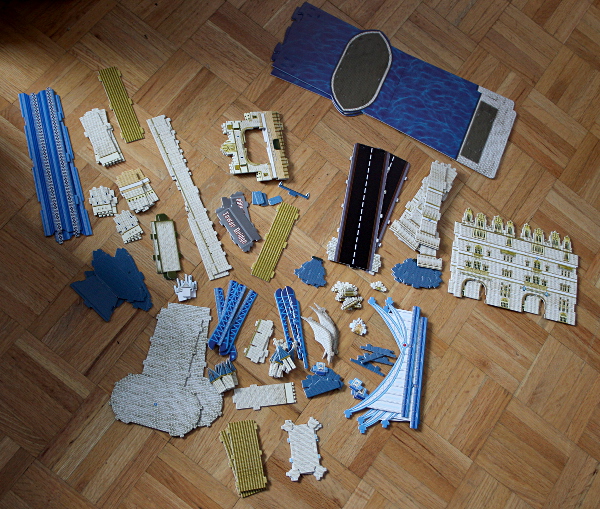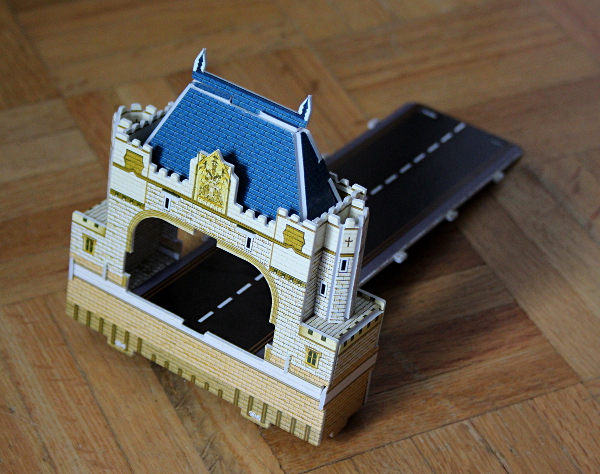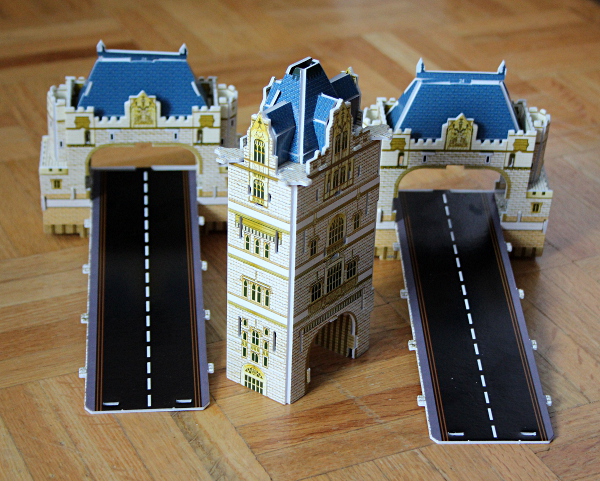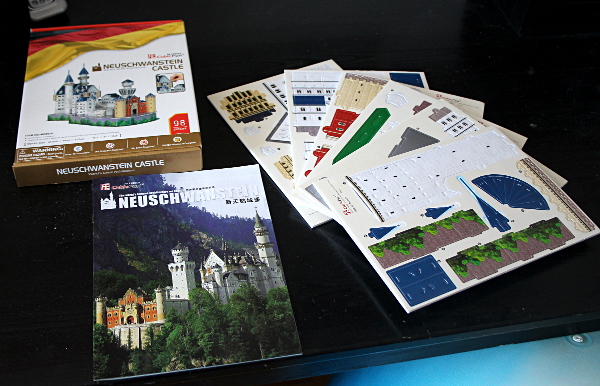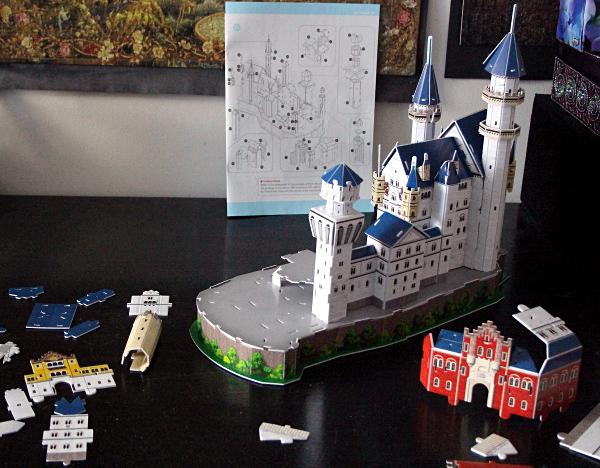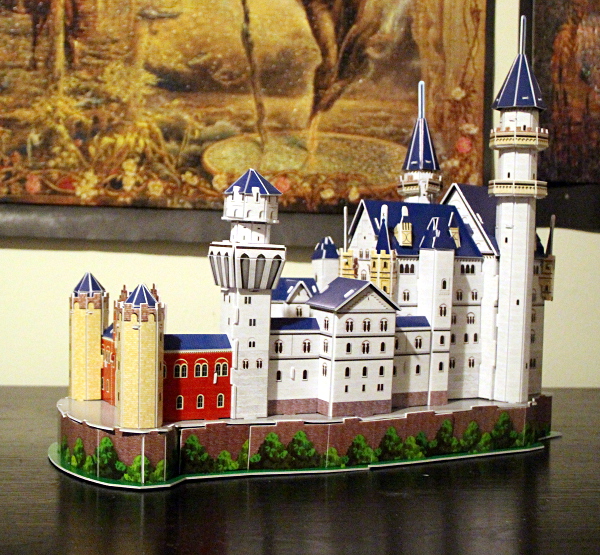Size: 750 pieces
Dimensions: 51cm x 68cm
Producer: Lafayette Puzzle Factory, Goldenline Fairies series, APL33650LK0812, #0213
Artist: Nadia Strelkina
Painting: photo
Box: photo
Puzzle: From the same series as Prisoner, this is a lovely colourful puzzle – a pleasure to do. The best places to start are the skin (face, neck, and hands), the moon, orange and yellow regions (tiger, light, window and gates), brown carriage near the moon and white carriage with a pegasus in the middle right, red dress and cape, castle roof and sky boundary, and the carriage in the bottom left. The darker colours at the bottom, the blue hues of the castle, the swirling mist, and darker blue and black of the top corners can come next. The colourful pieces of dress, trees, and remaining regions can then complete the picture. This puzzle has larger pieces and golden highlights.
Tag: puzzle
Puzzle: Sacred Circle by Steve Read
 Size: 500 pieces
Size: 500 pieces
Dimensions: 35.56cm x 45.72cm
Producer: Ceaco, Glow in the Dark series, 10-puzzle pack, 2013, No. 103013-21081-A
Artist: Steve Read
Illustration: original
Puzzle: A quick easy puzzle for an afternoon. Some good areas to start are the border between yellow floor and dark puzzle bottom, bright white light, lights from the staff and the candles, yellow circle of the floor, striped green radial pattern behind the wizard, the wizard’s face and beard, fuschia cloak lining, dragon’s wings, and boy’s arms. The candle holders make for good vertical guides, and so does the engraved pillar on the left side. Wizard’s and boy’s clothing, the throne, and the wall can then complete the assembly.
Puzzle: Dragon of the Lake
Size: 500 pieces
Dimensions: 35.56cm x 45.72cm
Producer: Ceaco, Glow in the Dark series, 10-puzzle pack, 2013, No. 103013-21081-A
Artist: Jan Patrik Krasny – Jan Patrik Krasny was born on 8. may 1955. He graduated from the Academy of Fine Arts in Prague (1976-1982). Since his childhood he has been attracted by comics, which he has published after 1989 in several magazines and newspapers. The core of his work are illustrations. He has created more than 400 cover-pages of mainly sci-fi & fantasy books for various Czech publishers. Recently he has been devoted to computer graphics. [Artist’s site]
Painting: original
Puzzle: Beautiful fantasy piece, making for a great puzzle. Best places to start are the lilac region of the sky at the top center, yellows and oranges of the mountains and sunlight, dark blue of the water in the bottom corners and the smaller dragon. For the larger dragon, a good sequence would be the head, the parts of the body bordering on yellow and orange, since they create an obvious contrast, followed by the rest of the body.
Notes: Illustration for Chris Meiklejohn’s Labyrinth Of Fire from the cycle Dragon Chronicles.
Puzzle: Zodiac
Size: 500 pieces
Dimensions: 35.56cm x 45.72cm
Producer: Ceaco, Glow in the Dark series, 10-puzzle pack, 2013, No. 103013-21081-A
Puzzle: Lovely colourful puzzle, a pleasure to do. Multiple distinct coloured areas, circular shape in the middle, frame outline, softer colours for the middle, and logical organization of the zodiac signs give many cues, making this puzzle trivial to assemble. I have started with the ornate frame and corners, the centerpiece, and the sun shapes at top and bottom center. Since most of the animals and figures have quite distinct colours, in combination with the coloured labels on the wheel, they were the next logical step, leaving very few pieces to finish up the puzzle.
Notes: In both astrology and historical astronomy, the zodiac is a circle of twelve 30° divisions of celestial longitude that are centered upon the ecliptic: the apparent path of the Sun across the celestial sphere over the course of the year. Historically, these twelve divisions are called signs. Essentially, the zodiac is a celestial coordinate system, or more specifically an ecliptic coordinate system, which takes the ecliptic as the origin of latitude, and the position of the sun at vernal equinox as the origin of longitude.
The term zodiac derives from Latin zōdiacus, which in its turn comes from the Greek, meaning “circle of animals”. The name is motivated by the fact that half of the signs of the classical Greek zodiac are represented as animals (besides two mythological hybrids). [Wiki]
Puzzle: Tower Bridge in London, 3D
Size: 120 pieces
Dimensions: 76 cm x 12 cm x 23 cm
Producer: CubicFun, 3D Puzzle series MC, #MC066h, complexity 5/6
Original packaging: http://www.cubicfun.com/index.php?m=Products&a=show&id=43&bid=1
Puzzle: Following the St. Basil’s Cathedral, Taj Mahal, Parliament Buildings of Canada, and Neuschwanstein Castle 3D puzzles, I have my people periodically checking our nearby Mrs. Tiggy Winkles toy store for higher-complexity puzzles made by CubicFun. And this time, we have found the Tower Bridge of London.
Here is the box, the booklet (see below for the historical information contained therein) and sheets with puzzle pieces.
I have done this in three stages:
1. Separating all the pieces from the sheets in which they were embedded.
2. Punching out the holes in the pieces (I used a tip of a mechanical pencil). My 3.5-year old was very excited about helping, and so he did most of the hole-punching while I fitted the pieces together.
3. And putting together the puzzle itself. Below are the progress photos (this time I had enough willpower to stop briefly to snap a few photos):
I recommend to be very attentive to the assembly of the two large towers and follow the letters on the base and the roof, to ensure that the corner towers are connected to the correct letters. Below is the photo of what NOT to do: notice the two holes around the balcony – those holes need to be facing the other way, toward the middle of the bridge, yet the towers attached to those corners need to face away from the middle of the bridge.
I had to re-do the two middle towers pictured above to face the holes the correct way in order to connect the two halves of the bridge.
Lots of fun putting the puzzle together, even though the final product is a bit flimsy. It is, I suppose unavoidable, considering the flexible nature of the bridge.
Notes from the puzzle booklet: “The world’s famous architecture we build it.
Tower Bridge is a combined bascule and suspension bridge in London, England over the River Thames. It is close to the Tower of London, which gives it its name. It has become an iconic symbol of London. Tower Bridge is one of several London bridges owned and maintained by the City Bridge Trust, a charitable trust overseen by the City of London Corporation.
Tower Bridge is sometimes mistakenly referred to as London Bridge, which is actually the next bridge up-stream. A popular urban legend is that, in 1968 Robert McCulloch, the purchaser of the old London Bridge which was later shipped to Lake Havasu City, Arizona, believed mistakenly that he was buying Tower Bridge, but this was denied by McCulloch himself and has been debunked by Ivan Luckin, the seller of the bridge. Its present colour dates from 1977 when it was painted red, white and blue for the Queen’s Silver Jubilee. Previous to this, it was painted a chocolate brown colour.
1910 The high-level walkways, which were designed so that the public could still cross the bridge when it was raised, were closed down due to lack of use. Most people preferred to wait at the bottom and watch the bascules rise up!
1912 During an emergency, Frank McClean had to fly between the bascules and the high-level walkways in his Short biplane, to avoid an accident.
1952 A London bus had to leap from one bascule to the other when the bridge began to rise with the bus still on it.
1977 Tower Bridge was painted red, white and blue to celebrate the Queen’s Silver Jubilee.
The walkways boast stunning views of the River Thames and many famous London sites, serving as viewing galleries for over 380,000 tourists who visit each year.
The bascules are raised around 1000 times a year. The bascules, weighing over 1,000 tones each, were counterbalanced to minimize the force required and allow raising in five minutes.
Tower Bridge is still a busy and vital crossing of the Thames: it is crossed by over 40,000 people (motorists and pedestrians) every day.
The tour value of Tower Bridge— There are the museum, exhibition hall, stores and saloons inside the Tower Bridge. HMS Belfast sails under Tower Bridge to take up her permanent mooring in the Pool of London.
In the New Year’s Eve, there is the catharine all over the the sky of the River Thames. Old-timey Architecture, the fragrance of the beer from the saloon, the jow fom the church, and the vintage taxi surround the Tower Bridge, makes people go backward to the London in The Nineteenth Century.” [sic, booklet included with the puzzle]
Puzzle: Neuschwanstein Castle in 3D
 Size: 98 pieces
Size: 98 pieces
Dimensions: 41.5 cm x 18 cm x 33.5 cm
Producer: CubicFun, 3D Puzzle series MC, #MC062h, complexity 5/6
Puzzle: Following the St. Basil’s Cathedral, the Taj Mahal, and the Parliament Buildings of Canada 3D puzzles, I am now perpetually on the lookout for other higher-complexity puzzles made by CubicFun, and my partner found one in a nearby toy store (Mrs. Tiggy Winkles), getting it for me as a surprise the weekend when I was sick.
Here is the box, the booklet (see below for the historical information contained therein) and sheets with puzzle pieces.
I have done this in three stages:
1. Separating all the pieces from the sheets in which they were embedded.
2. Punching out the holes in the pieces (I used a tip of a mechanical pencil).
3. And putting together the puzzle itself. Below are the progress photos:
I have quite enjoyed this puzzle. It is well-made and the castle looks beautiful when assembled.
Notes from the puzzle booklet:
Please note that I have not changed any spelling or grammar.
“The world’s famous architecture we build it. Neuschwanstein.
Neuschwanstein Castle
Neuschwanstein is a 19th-century Bavarian palace on a rugged hill near Hohenschwangau and Füssen in southwest Bavaria, Germany. The palace was commissioned by Ludwig II of Bavaria as a retreat and as a homage to Richard Wagner, the King’s inspiring muse. Although public photography of the interior is not permitted, it is the most photographed building in Germany and is one of the country’s most popular tourist destinations.
Today Neuschwanstein is one of the most popular of all the palaces and castles in Europe. Every year 1.3 million people visit “the castle of the fairy-tale king”. In the summer around 6,000 visitors a day stream through rooms that were intended for a single inhabitant.
The prince was born on the name day of the canonized Louis IX, King of France and founder of the House of Bourbon. Ludwig II was possessed by the idea of a holy kingdom by the Grace of God. In reality he was a constitutional monarch, a head of state with rights and duties and little freedom of action. For this reason he built a fantasy world around him in which – far removed from reality – he could feel he was a real king.
The conception of the palace was outlined by Ludwig II in a letter to Richard Wagner, dated May 13, 1868; “It is my intention to rebuild the old castle ruin at Hohenschwangau near the Pollat Gorge in the authentic style of the old German knights’ castles… the location is the most beautiful one could find, holy and unapproachable, a worthy temple for the divine friend who has brought salvation and true blessing to the world.”
Woodcarving in Ludwig’s bedroom took 14 carpenters 4 1/2 years to complete. The Monarch’s bed is crowned by the most intricate woodcarving and covered with richly Embroider draperies.
Gardons were built behind the Neuschwanstein Castle.
The Throne Room was created as the Grail-Hall of Parsifal. It was designed in elaborate Byzantine style. It was inspired by the Hagia Sophia in Constantinople (now Istanbul), the 2 story throne room with its series of pillars of imitation porphyry and lapis lazuli, was completed in the year of the Kings death in 1886.
The throne room, which features a glass gem-encrusted chandelier; all Twelve Apostles and six canonised kings are painted on the wall that surrounds the pedestal for the throne – the actual throne was never finished.
Just imagine a mysterious stalactite cavern just between the Living Room and the Study Ludwig II. Magnificent and charming!
The region is full of mountains, forests, meadows, lakes, cycle paths… It proposes more you can ever think possible.
Today Neuschwanstein is one of the most popular of all the palaces and castles in Europe. It is also nominated as one of the New Seven Wonders of the World.
Every year 1.3 million people visit “the castle of the fairy-tale king”. In the summer around 6,000 visitors a day stream through rooms that were intended for a single inhabitant.” [Puzzle booklet]
Puzzle: Sunset Blaze by Viktor Shvaiko
Size: 504 pieces
Dimensions: 45.7 cm x 27.3 cm
Producer: Sure-Lox pieces. Company unknown – I do not have the box anymore. If you have this information, please do share. There were 4 puzzles in the box: Autumn in Paris, Buca Francesco, Rue Lafayette Paris, and Sunset Blaze – all by the same artist.
Artist: Viktor Shvaiko
Puzzle: I have assembled a 1000-piece version of this puzzle a few years ago. It is a lovely and easy puzzle to do. The best regions to start are the yellow and blue sky, the mountain range, the sign over the sky, and the vertical guides of the building/sky border, the arches, and the door frame. The bright red chair, the orange ledge in the bottom center, the letters above the entrance, the terrace floor and the table are easily put together. The border of the city and the mountains, as well as the red-roofed houses can come next, followed by the flower arrangements around the arch. This leaves the green of trees and grass, the building interior, and the flowers growing around the ledge. Beautiful scenery.
Puzzle: Buca Francesco by Viktor Shvaiko
Size: 504 pieces
Dimensions: 45.7 cm x 27.3 cm
Producer: Sure-Lox pieces. Company unknown – I do not have the box anymore. If you have this information, please do share. There were 4 puzzles in the box: Autumn in Paris, Buca Francesco, Rue Lafayette Paris, and Sunset Blaze – all by the same artist.
Artist: Viktor Shvaiko
Puzzle: Lovely puzzle with beautiful imagery and well-fitting Sure-Lox pieces. The easiest places to start are the sky, the water, the boats, and the vertical guides of building borders and corners where the colour contrast is the greatest. The bridge, the yellow building walls, the lilac flower in the top right quarter, the balconies, the table and chair backs, the lanterns and their reflections, and the banister with the flower planters can be put together next, leaving the arches, the windows, and the interior of the Buca Francesco building to fill in.
Puzzle: Rue Lafayette Paris by Viktor Shvaiko
Size: 504 pieces
Dimensions: 45.7 cm x 27.3 cm
Producer: Sure-Lox pieces. Company unknown – I do not have the box anymore. If you have this information, please do share. There were 4 puzzles in the box: Autumn in Paris, Buca Francesco, Rue Lafayette Paris, and Sunset Blaze – all by the same artist.
Artist: Viktor Shvaiko
Puzzle: Crisp and bright colours, clear borders, and well-fitting Sure-Lox pieces make this puzzle a breeze to do. Easiest regions to start are the store banners with writing, the yellow-flowered green vine, the blue booth, the various flower arrangements, the window in the top left corner, and the table and chairs on the right. The pavement, the painting above the blue booth, and the arch with the lantern can come next, leaving the buildings further away and the smaller detail of the storefronts to complete the puzzle.
Puzzle: Autumn in Paris by Viktor Shvaiko
Size: 504 pieces
Dimensions: 45.7 cm x 27.3 cm
Producer: Sure-Lox pieces. Company unknown – I do not have the box anymore. If you have this information, please do share. There were 4 puzzles in the box: Autumn in Paris, Buca Francesco, Rue Lafayette Paris, and Sunset Blaze – all by the same artist.
Artist: Viktor Shvaiko – Russian artist Viktor Shvaiko was born August 23, 1965 in the Altai region. He grew up among the beautiful and rich landscapes of Siberian nature. He vision of beauty and passion for art helped him to enter the Novoaltaisk Artistic School. After graduation Viktor Shvaiko and his family left Altai for Pridnestrovie (Transkarpthia). There first exhibition of paintings was in Moukachevo in 1990, then a group exhibition in Hungary in 1991, and in Russia. In 1991 Viktor Shvaiko went to Italy. It was there Russian traveling artist Viktor Shvaiko painted beautiful images of cosy cafe areas around Italy, also in France. These paintings full of light illuminate the beauty of sunsets and dawns on the background of cityscapes. [All of Russia site]
Puzzle: A beautiful puzzle, easy to do due to its small size and well-fitting Sure-Lox pieces. Great places to start are the red storefront with yellow letters, the beige and brown wall regions above, the Pharmacie banners, the blue store front on the crossing street, and the grey windows in the top right corner. The pavement, yellow leaves, white pavement borders, and the painting above Pharmacie sign can be completed next, leaving the black Pharmacie store front, the windows above the red store front, and a few other small regions to complete the puzzle.
Puzzle: Colmar, Alsace, France
Size: 1000 pieces
Dimensions: 66.52cm x 51.12cm
Producer: Big Ben
Puzzle: Beautiful puzzle, not completely trivial, due to many small colourful regions. Some of the best places to tackle first are the blue of the sky and the water, sky and rooftop boundary, bright yellow regions, and the orange and grey building in the right quarter of the picture. The white umbrellas, green neon lights, umbrella reflections, and tall building in the centre and its reflection can be assembled next, leaving many smaller regions to complete the puzzle.
Notes: Colmar is the third-largest commune of the Alsace region in north-eastern France. Colmar was founded in the 9th century. Colmar’s secular and religious architectural landmarks reflect eight centuries of Germanic and French architecture and the adaptation of their respective stylistic language to the local customs and building materials (pink and yellow Vosges sandstone, timber framing).
The Municipal Library of Colmar owns one of the richest collections of incunabula in France, with more than 2,300 volumes. This is quite an exceptional number for a city that is neither the main seat of a university, nor of a college, and has its explanation in the disowning of local monasteries, abbeys and convents during the French Revolution and the subsequent gift of their collections to the town. [Wiki]
Puzzle: San Joseph Church, Sicily, Italy
 Size: 1000 pieces
Size: 1000 pieces
Dimensions: 51.12cm x 66.52cm
Producer: Hasbro, MB Puzzles, Big Ben, 2008, 04962-W42
Photographer: R. Kord/Robertstock
Puzzle: Not a completely trivial puzzle, but quite serene to put together with its tree blooms and a magnificent building. Good places to start are the border between the mountains and the sky, the outline of the church against the mountain, the horizontal guide of the pavement against the building base, the vertical guides of the pillars and tree trunks, the arch between the pillars of the bell tower, and the statue with the cross. That splits the puzzle up into smaller regions that are easier to tackle. The uniform white and beige of the walls, the balustrade, the pink blooms, and the pavement can be completed next. For the rest of the puzzle, good lighting is a plus.
Notes: I have found a lovely picture of this church at the Walks of Italy site.
It is situated in Taormina – a small town on the east coast of the island of Sicily, Italy, in the Province of Messina. Taormina has popular beaches on the Ionian sea, which is remarkably warm and has a high salt content. The present town of Taormina occupies the ancient site, on a lofty hill. Portions of the ancient walls may be traced at intervals all round the brow of the hill, the whole of the summit of which was evidently occupied by the ancient city. Numerous fragments of ancient buildings are scattered over its whole surface, including extensive reservoirs of water, sepulchres, tesselated pavements, etc., and the remains of a spacious edifice, commonly called a Naumachia, but the real purpose of which it is difficult to determine. [Wiki]
Puzzle: Dinosaurs
 Size: 100 pieces
Size: 100 pieces
Dimensions: 22.86cm x 17.78cm
Producer: Ceaco, Glow in the Dark series, 10-puzzle pack, 2013, No. 103013-21081-A
Puzzle: A trivial puzzle for an adult, a bit of a challenge for my 3.5-year old. He needed a little help putting this puzzle together, but has enjoyed it. We have tackled the sky with the flying creatures first, the blue water at the bottom next, and the rainbow-coloured-scale stegosaurus in the bottom right next. The long-necked creatures came afterwards, followed by those ones in the bottom left corner.
Puzzle: Direwood
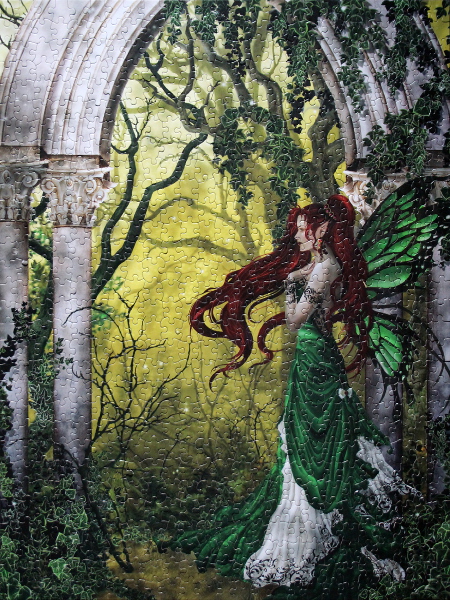 Size: 750 pieces
Size: 750 pieces
Dimensions: 46cm x 61cm
Producer: Ceaco, Nene Thomas, series 2, 2012, 2993-4, No. 083013-21081-A
Artist: Nene Thomas
Painting: original
Puzzle: Another Ceaco puzzle based on the artwork by Nene Thomas, from the same series as A Chance Encounter. This one is much easier to complete, as there are vibrant hues and clear borders between them. The easiest regions to start are the green and white of the dress, the red of the hair, and the yellow background with tree branches. I have followed that with the arch and pillars, as the colour is quite distinct. This leaves the hanging branches at the top and the growing plants at the bottom. The puzzle is not large and the colours are bright, making it a pleasure to assemble.
Puzzle: A Chance Encounter
 Size: 750 pieces
Size: 750 pieces
Dimensions: 61cm x 46cm
Producer: Ceaco, Nene Thomas, series 2, 2012, 2993-6, No. 083013-21081-A
Artist: Nene Thomas
Painting: original
Puzzle: Not a trivial puzzle to do, as almost all of it is grey scale or near enough. The best guides are clear borders between black and white, and the regions of black dress and harness, black dragon, white mane, snow, and white folds of the dress, so those are good regions to start. Most of the remaining picture is the web of tree branches. Good patterns to look for are the darker vs lighter greys. Thicker branches and trunks make good vertical guides. At this point, it might be helpful to sort the remaining pieces by shape, and work along the borders of empty regions. Good lighting is a plus.
Puzzle: High Sierra Reflections
 Size: 1000 pieces
Size: 1000 pieces
Dimensions: 48.10cm x 67.95cm
Producer: Mega Brands, Vibrant series, 2013, No. 51420ABN, A28103LP
Photographer: Elizabeth Carmel
Photo: original
Puzzle: A bit on a challenging side, this puzzle benefits from having good lighting and patience. As with most reflection puzzles, it benefits from having the line of the horizon as a horizontal guide, splitting the image into two distinct regions. This line, as well as the borders between the mountain range and the sky, together with its reflection, are good places to start. Another convenient clear border is between the dark evergreen trees and the mountain, again duplicated in the reflection. The bright green patch of the grass on the right, the water, and the sky are the next logical regions to complete, leaving a large are of the grass stalks, which presents the most challenge. Here good lighting, as well as colour and stalk size distinctions are the best helpers.
Notes: As the box does not specify where exactly this photo is taken, I assume that High Sierra refers to a region in the Sierra Nevada mountain range.
It is a mountain range in the western United States, between the Central Valley of California and the Basin and Range Province. The Sierra Nevada has a significant history. The California Gold Rush occurred in the western foothills from 1848 through 1855. Due to inaccessibility, the range was not fully explored until 1912. Today, some mountain passes, such as Duck Pass with obsidian arrowheads, are artifact locations from historic intertribal trade route trails.
The literal translation of Sierra Nevada is “snowy mountains,” from sierra “a range of hills,” 1610s, from Spanish sierra “jagged mountain range,” lit. “saw,” from Latin serra “a saw”; and from fem. of Spanish nevado “snowy.” [Wiki]
Puzzle: Dragon Isle

Size: 500 pieces
Dimensions: 35.56cm x 45.72cm
Producer: Ceaco?, Meiklejohn Graphics, Glows in the Dark! series
Artist: Meiklejohn Graphics
Puzzle: A fun and not too complicated puzzle to do. A good place to start would be the blue segments of the wings, the waves at the bottom, and the red and orange background behind the dragon’s back. The dragon’s armour and tail are relatively easy areas to complete as well. Darker background regions and light-coloured rocks at the bottom are distinct enough as well, leaving the remaining few areas simple to finish. The pieces are large and easy to place.
Puzzle: Golden Light
 Size: 1000 pieces
Size: 1000 pieces
Dimensions: 67.95 cm x 48.1 cm
Producer: Mega Puzzles, Vibrant series, 2013, No. 51420AAN, A 29073 LP
Artist: Adrian Klein
Original: Golden Light
Puzzle: Not a trivial puzzle, but a calming one to do, listening to some zen music or a good narrative. I would say a good region to get started is the horizon line separating the snow from the water. This line splits the puzzle into two areas, providing a horizontal guide. The darker blue regions in the corners of the puzzle and a dark rounded stone area in the top left, as well as the bright blue patches of snow on the mountain slope and their reflections in the water could be tackled next. For the trees, I found it easiest to start with the reflections in the water, as the ripples assist in determining the orientation of the pieces. The few rocks in the water and darker patches of land on the shore are distinctive as well. For the trees above water, tree trunks can serve as vertical guides. The gradients in the water, from yellow to blue, allow for gradual completion of that region, from light to dark. I have enjoyed this puzzle quite a bit.
Notes: “Larches turned gold in fall along the lakes The Enchantments in Alpine Lakes Wilderness, Washington while backpacking with my friend Zack Schnepf.” [Adrian Klein site]
Puzzle: Grand Canyon, Arizona, U.S.A.
Size: 750 pieces
Dimensions: 59.69 cm x 39.37 cm
Producer: Sure-Lox, The Canadian Group
Puzzle: A beautiful puzzle, a pleasure to do. Might be a little challenging for a beginner, due to the large areas of orange rock. The sky is only 4 pieces deep, with a clearly defined bottom boundary with the rock, the sea area is well-defined with two arc shapes of foam dividing it into easily-managed gradient-coloured regions. The trees at the bottom right and the top of the orange rock are darker than almost anything else in the puzzle. All these regions are good places to start. The bright green trees help split the bottom left region into separate areas. The white gnarled tree in the bottom right quarter is also quite distinct. That leaves the orange rock and the white ground with trees in the lower left quarter, and a few areas of colour fading between already-completed regions.
Notes: I have completed quite a few puzzles depicting the Grand Canyon so far.
Puzzle: Kirwan – Dream of Euripides
Size: 500 pieces
Dimensions: 48.26cm in diameter
Producer: American Publishing & Television, Candu Toy & Sport Co. Inc, 1995, Rose Art Industries, Made in USA, No. 6524 (thank you to PuzzleMan for the producer information)
Artist: Jim Kirwan
Painting: original
Puzzle: A beautiful painting bringing to forefront the issues of ecology, consumerism, and the police state. The artist explores the two sides of the coin: how we see the idyllic society and what it costs in the environmental damage and lack of freedoms.
A fun puzzle to do, not very trivial for a beginner, mostly due to nearly-uniform colouring of the puzzle border pieces, and a large uniformly-patterned area in the bottom half. Easiest places to start are the “no”, “don’t”, and “stop” signs, yellow and blue outburst in the bottom left quarter, the horizontal separating black band between the top and bottom halves, and the smaller circle with two halves. In the top half, the sky and the sea, the sailboat, the tree and mountains bordering on the sky, and the red window are good as starting regions. The yellow leaves and the buildings in the top half and the smoke and brighter red and yellow spots are easy to distinguish. Once all these are in place, the puzzle is small enough to make the rest manageable.
Notes: “The symbol for Ecology was created by Euripides; it was a simple circle with a single horizontal line through the middle. In this version of that idea the world is portrayed in two extremes: in the upper portion of the painting the world seems almost idyllic; proportional; and livable with breathing room, clean water, and real possibilities without apparent limits.
In the lower half, concealed from what we think of as our opportunities; we can see what we have made of that bright vision of that fantasy world above. Pollution, oil pumps, the roots of the world amid the chaos of our failures and the trash we so abundantly produce in mega-volumes. That is what we have allowed ‘the developed world’ to become: A world composed of “NO” and “DON’T” and “STOP.” It is a world without light or grace or freedom of any kind. It is the underbelly of unchecked capitalism as we practice it and as we worship the material- philosophy with an incessant and nearly religious ‘consumerism.'” [Jim Kirwan on Rense.com]











